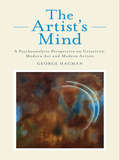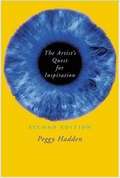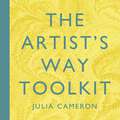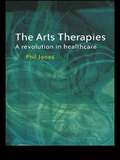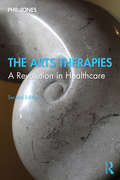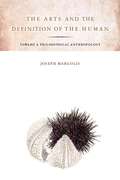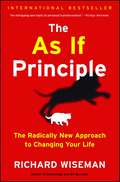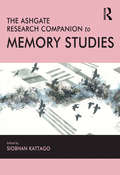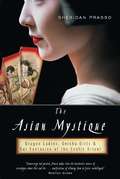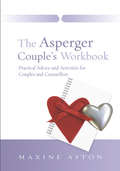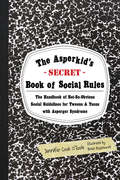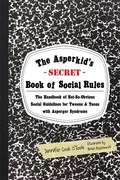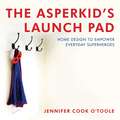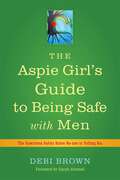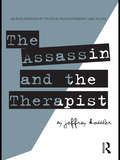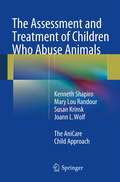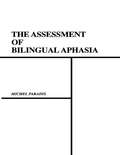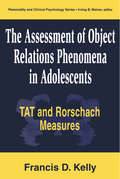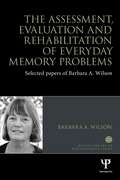- Table View
- List View
The Artificial Womb on Trial (Elements in Bioethics and Neuroethics)
by Teresa BaronArtificial womb technology is approaching over the scientific horizon. Recent proof-of-principle experiments using foetal animals have prompted a new surge of bioethical interest in the topic: scholars have asked what ectogenesis would mean for individuals, family, oppressed groups, and society at large; how we can or should regulate the technology; and whose interests motivate ectogenic research. However, a full investigation of the bioethics of ectogenesis must ask, 'how do we get there?' This Element places the research and development process itself under the microscope and explores the bioethical issues raised by human subject trials of ectogenic prototypes. This title is also available as Open Access on Cambridge Core.
The Artist's Mind: A Psychoanalytic Perspective on Creativity, Modern Art and Modern Artists
by George HagmanFor the past century psychoanalysts have attempted to understand the psychology of art, artists and aesthetic experience. This book examines how contemporary psychoanalytic theory provides insight into understanding the psychological sources of creativity, Modern Art and modern artists. The Artist’s Mind revisits the lives of eight modern artists including Henri Matisse, Marcel Duchamp, Jackson Pollock and Andy Warhol, from a psychoanalytical viewpoint. It looks at how opportunities for a new approach to art at the turn of the twentieth century offered artists a chance to explore different forms of creativity and artistic ambition. Key areas of discussion include: developmental sources of the aesthetic sense psychological functions of creativity and art psychology of beauty, ugliness and the Sublime. co-evolution of the modern self, modernism and art. cultural context of creativity, artistic identify and aesthetic experience. Through the examination of great artists’ lives and psychological dynamics, the author articulates a new psychoanalytic aesthetic model that has both clinical and historical significance. As such this book is essential reading for all those with an interest in the origins and fate of Modern Art.
The Artist's Quest of Inspiration
by Peggy HaddenUpdated to inspire a new generation of visual artists in their quest for creative growth, this book shows artists how they can experience a new awakening of creativity and add fresh meaning to their work by using simple techniques found in this inspirational guide. A working artist who has coped successfully with the daily challenge of facing a blank canvas shares her methods for overcoming creative blocks.Allworth Press, an imprint of Skyhorse Publishing, publishes a broad range of books on the visual and performing arts, with emphasis on the business of art. Our titles cover subjects such as graphic design, theater, branding, fine art, photography, interior design, writing, acting, film, how to start careers, business and legal forms, business practices, and more. While we don't aspire to publish a New York Times bestseller or a national bestseller, we are deeply committed to quality books that help creative professionals succeed and thrive. We often publish in areas overlooked by other publishers and welcome the author whose expertise can help our audience of readers.
The Artist's Way Toolkit: How to Use the Creative Practices
by Julia CameronHailed as the Queen of Creativity, Julia Cameron is the authority on artistic life and has brought her wisdom to millions around the world. The four essential, accessible tools she has been famed for over her lifelong career-MorningPages, Artist Dates, Walks and Guidance- have transformed lives. Now, for the first time, they are presented together, along with her readers' most commonly asked questions.Offering a deep dive into each tool, Cameron demonstrates how to set ourselves firmly on path to self-love and creative nourishment. Thanks to the learned experience of a lifetime of teaching and writing about creative recovery, she generously delivers inspiring stories and practices to guide us back to discovery.
The Artist's Way, A Spiritual Path to Higher Creativity
by Julia CameronThe Artist's Way is the seminal book on the subject of creativity. An international bestseller, it's an invaluable guide to living the artist's life. Perhaps even more vital in today's cultural climate than when it was first published a decade ago, it is a powerfully provocative and inspiring work. In a new introduction to the book, Julia Cameron reflects on the impact of The Artists Way and describes her work over the last decade and the deep insights into the creative process she has gained. Now updated, this anniversary edition ushers The Artist's Way into a new century. JULIA CAMERON has been an active artist for more than thirty years. She is the author of seventeen books, fiction and nonfiction, including The Artist's Way, The Vein of Gold, and The Right to Write, her bestselling works on the creative process. A novelist, playwright, songwriter, and poet,she has multiple credits in theater, film, and television. She divides her time between Manhattan and the high desert of New Mexico.
The Arts Therapies: A Revolution in Healthcare
by Phil JonesThe Arts Therapies provides, in one volume, a guide to the different disciplines and their current practice and thinking. It presents:* A clear analysis of the relationship between client, therapist and art form.* An exploration of research, practice and key contributions made to the field by practitioners internationally and within many different contexts.* Discussion of how the arts therapies relate to established health services.The Arts Therapies: A revolution in healthcare is a unique book that provides a thorough and up-to-date overview of the arts therapies. It will prove invaluable to arts therapists, health professionals, and all those who wish to learn more about the field.
The Arts Therapies: A Revolution in Healthcare
by Phil JonesThe separate arts therapies – drama, art, music and dance – are becoming available to increasing numbers of clients as mental health professionals discover their potential to reach and help people. But what are the arts therapies, and what do they offer clients? This fully updated new edition of The Arts Therapies provides, in one volume, a guide to the different disciplines and their current practice and thinking in different parts of the world. Each chapter draws on a variety of perspectives and accounts to develop understandings of the relations between theory, research and practice, offering perspectives on areas such as the client-therapist-art form relationship or on outcomes and efficacy to help articulate and understand what the arts therapies can offer specific client groups. This new edition features ‘Focus on Research’ highlights from music therapy, art therapy, dramatherapy and dance movement therapy, which offer interviews with researchers in China, Africa, South America, Australia, Europe and North America, exploring significant pieces of enquiry undertaken within recent years. This comprehensive overview will be an essential text for students and practitioners of the arts therapies. It is international in scope, fully up-to-date with innovations in the field and will be relevant to new practitioners and those looking to deepen their understanding.
The Arts and the Definition of the Human
by Joseph MargolisThe Arts and the Definition of the Humanintroduces a novel theory that our selves-our thoughts, perceptions, creativity, and other qualities that make us human-are determined by our place in history, and more particularly by our culture and language. Margolis rejects the idea that any concepts or truths remain fixed and objective through the flow of history and reveals that this theory of the human being (or "philosophical anthropology") as culturally determined and changing is necessary to make sense of art. He shows that a painting, sculpture, or poem cannot have a single correct interpretation because our creation and perception of art will always be mitigated by our historical and cultural contexts. Calling upon philosophers ranging from Parmenides and Plato to Kant, Hegel, and Wittgenstein, art historians from Damisch to Elkins, artists from Van Eyck to Michelangelo to Wordsworth to Duchamp, Margolis creates a philosophy of art interwoven with his philosophical anthropology which pointedly challenges prevailing views of the fine arts and the nature of personhood.
The Arts of Contemplative Care
by Judith Simmer-Brown Pat Enkyo O'Hara Cheryl A Giles Willa B MillerPowerful and life-affirming, this watershed volume brings together the voices of pioneers in the field of contemplative care--from hospice and hospitals to colleges, prisons, and the military. Illustrating the day-to-day words and actions of pastoral workers, each first-person essay in this collection offers a distillation of the wisdom gained over years of compassionate experience. The stories told here are sure to inspire--whether you are a professional caregiver or simply feel inclined toward guiding, healing, and comforting roles. If you are inspired to read this book, or even one touching story in it, you just might find yourself inspired to change a life.
The Arts of Contemplative Care: Pioneering Voices in Buddhist Chaplaincy and Pastoral Work
by Judith Simmer-Brown Pat Enkyo O'Hara Cheryl A Giles Willa B MillerPowerful and life-affirming, this watershed volume brings together the voices of pioneers in the field of contemplative care--from hospice and hospitals to colleges, prisons, and the military. Illustrating the day-to-day words and actions of pastoral workers, each first-person essay in this collection offers a distillation of the wisdom gained over years of compassionate experience. The stories told here are sure to inspire--whether you are a professional caregiver or simply feel inclined toward guiding, healing, and comforting roles. If you are inspired to read this book, or even one touching story in it, you just might find yourself inspired to change a life.
The As If Principle
by Richard WisemanVictorian philosopher William James had a theory about emotion and behavior: It isn't that our feelings guide our actions (feel happy and you will laugh). On the contrary, it is our actions that guide our emotions (laugh and you will feel happy). This led James to a remarkable conclusion: "If you want a quality, act as if you already have it." Roused by James's astonishing discovery, renowned psychologist and bestselling author Richard Wiseman confirms James's principle and shows how the self-help genre has for too long put the cart before the horse in trying to help us take control of our lives. Bringing to the table a dazzling array of firsthand experiments, surprising histories, and psychological case studies, Wiseman illustrates in brilliant detail how we can apply this principle in our daily lives: --Smile to become measurably happier --Wash your hands to drive away guilt --Clench your fist to increase your willpower --Eat with your non-dominant hand to lose weight --Nod while speaking to become more persuasive --Act like a newlywed to rekindle your marriage Lively, engaging, and truly mind-changing, The As If Principle is that rare gem that offers real, workable solutions for your day-to-day goals while helping you to instantly take control of your emotions. Whether it's quitting a bad habit, persevering through a difficult task, or achieving your dream self, The As If Principle can help. Don't just think about changing your life. Do it.
The Ashgate Research Companion to Memory Studies
by Siobhan KattagoMemory has long been a subject of fascination for poets, artists, philosophers and historians. This timely volume, edited by Siobhan Kattago, examines how past events are remembered, contested, forgotten, learned from and shared with others. Each author in The Ashgate Research Companion to Memory Studies has been asked to reflect on his or her research companions as a scholar, who studies memory. The original studies presented in the volume are written by leading experts, who emphasize both the continuity of heritage and tradition, as well as the memory of hostilities, traumas and painful events. Comprised of four thematic sections, The Ashgate Research Companion to Memory Studies provides a comprehensive overview of the latest research within the discipline. The principal themes include: ¢ Memory, History and Time ¢ Social, Psychological and Cultural Frameworks of Memory ¢ Acts and Places of Memory ¢ Politics of Memory, Forgetting and Democracy Featuring contributions from key thinkers in the field, this comprehensive volume will be a valuable resource for all academics and students working within this area of study.
The Asian Mystique: Dragon Ladies, Geisha Girls, and Our Fantasies of the Exotic Orient
by Sheridan PrassoFew Westerners escape the images, expectations and misperceptions that lead us to see Asia as exotic, sensual, decadent, dangerous, and mysterious. Despite -- and because of -- centuries of East-West interaction, the stereotypes of Western literature, stage, and screen remain pervasive icons: the tea-pouring, submissive, sexually available geisha girl; the steely cold dragon lady dominatrix; as well as the portrayal of the Asian male as effeminate and asexual. These "Oriental" illusions color our relations and relationships in ways even well-respected professional "Asia hands" and scholars don't necessarily see. The Asian Mystique lays out a provocative challenge to see Asia and Asians as they really are, with unclouded, deeroticized eyes. It traces the origins of Western stereotypes in history and in Hollywood, examines the phenomenon of 'yellow fever,' then goes on a reality tour of Asia's go-go bars, middle-class homes, college campuses, business districts, and corridors of power, providing intimate profiles of women's lives and vivid portraits of the human side of an Asia we usually mythologize too well to really understand. It strips away our misconceptions and stereotypes, revealing instead the fully dimensional human beings beyond our usual perceptions. The Asian Mystique is required reading for anyone with interest in or interaction with Asia or Asian-origin people, as well as any serious student or practicioner of East-West relations.
The Asperger Couple's Workbook: Practical Advice and Activities for Couples and Counsellors
by Maxine AstonAsperger Syndrome (AS) can affect some of the fundamental ingredients required to make a relationship work, such as emotional empathy and communication. Maxine Aston, author of Aspergers in Love, has created this workbook to help couples where one of the partners has Asperger Syndrome deal with the difficulties that may arise in their relationship. With candid advice, activities and example worksheets, the book explores a variety of approaches that couples can use to counteract these difficulties. Whilst acknowledging that all relationships are different and each needs to be viewed as a unique case, the author identifies specific issues that can be problematic in an Asperger relationship, such verbal and non-verbal communication, sexual issues, socializing and parenting, and comes up with simple and effective ways of addressing these issues. This practical book is designed for use by couples and families affected by AS, either on their own or in conjunction with a counsellor. It will also be of interest to couples counsellors, or other professionals working with people with AS.
The Asperkid's (Secret) Book of Social Rules: The Handbook of Not-So-Obvious Social Guidelines for Tweens and Teens with Asperger Syndrome
by Jennifer Cook O'Toole Brian BojanowskiBeing a teen or tween isn't easy for anyone but it can be especially tough for Asperkids. Jennifer O'Toole knows; she was one! This book is a top secret guide to all of the hidden social rules in life that often seem strange and confusing to young people with Asperger syndrome. The Asperkid's (Secret) Book of Social Rules offers witty and wise insights into baffling social codes such as making and keeping friends, blending in versus standing out from the crowd, and common conversation pitfalls. Chock full of illustrations, logical explanations, and comic strip practice sessions, this is the handbook that every adult Aspie wishes they'd had growing up. Ideal for all 10-17 year olds with Asperger syndrome, this book provides inside information on over thirty social rules in bite-sized chunks that older children will enjoy, understand, and most importantly use daily to navigate the mysterious world around them.
The Asperkid's (Secret) Book of Social Rules: The Handbook of Not-So-Obvious Social Guidelines for Tweens and Teens with Asperger Syndrome
by Jennifer Cook O'TooleThis book is meant for asperkids and offers insights into baffling social codes such as making and keeping friends, blending in versus standing out from the crowd, and common conversation pitfalls, provides inside information on over thirty social rules in bite-sized chunks that older children can enjoy and understand.
The Asperkid's Launch Pad: Home Design to Empower Everyday Superheroes
by Jennifer Cook O'TooleFor Asperkids, home is both their protected lair and their launch pad into success in a neurotypical world. Jennifer O'Toole provides parents with all the help they need in planning their home environment to encourage their Asperkid superheroes to soar. The Asperkid's Launch Pad is a visually-led guide to preparing a home environment that supports the development of children with Asperger syndrome. From a bedroom light switch that the child can easily reach, to a tucked-away safe place that he or she can retreat to when feeling overwhelmed or anxious, small changes in the home can boost the child's self-confidence, independence, comfort and life skills. Award-winning author Jennifer O'Toole gives readers a walk-through tour of the home, showing, room by room, how physical surroundings affect Asperkids and highlighting the learning opportunities in every space and object. Beautifully presented with color photographs throughout, this functional and fun book will win a place in the homes and hearts of all parents of children with Asperger syndrome.
The Aspie Girl's Guide to Being Safe with Men: The Unwritten Safety Rules No-one is Telling You
by Sarah Attwood Debi BrownFor Aspie girls and women, dating and sexual relationships can be confusing, intimidating and potentially dangerous. Even if actively avoiding romantic relationships or sexual encounters, a lack of understanding about acceptable social interaction between men and women can leave Aspies vulnerable to negative experiences. It is vital, therefore, that the facts and unwritten rules about sexual conduct and relationships are clearly laid out for girls and women on the spectrum. Understanding that Aspies need explanations to be explicit and unambiguous, Debi Brown, a female on the spectrum, presents the truth about sex and relationships, shares her personal insight and provides practical strategies for staying safe in many different situations. As she guides Aspies through the unwritten safety rules around dating, relationships and sex, her advice will empower females on the spectrum, allowing them to build up their knowledge, recognise and report abusive behaviour, understand boundaries, develop relationship skills and work towards a safe independence. Covering topics such as boyfriends, sex, pregnancy and rape, this book includes advice on building a support network, saying 'no', self-esteem and emotional healing and will prepare Aspie girls and women to make independent, informed and safe decisions when interacting with men. Written with warmth, honesty and understanding, this is essential reading for every Aspie girl and woman, from age 13 upwards. It will also be a valuable source of insight and advice for parents, friends, professionals and anyone else supporting a female on the autism spectrum.
The Assassin And The Therapist: An Exploration Of Truth In Psychotherapy And In Life
by Jeffrey A. KottlerMany therapists have likely worked with a client who has caused the therapist to confront his most cherished beliefs, or has changed the therapist in ways that forever altered the way he performs therapy, looks at the world, and sees himself. The author of this book found himself in just such a situation, causing him to begin his own search for truth. This book is the result of his search; it explores the nature of truth in psychotherapy and in the therapist's life, examining some of the things that are often denied and rarely spoken about. This book contains two parallel narratives: the first tells the story of Jacob, a man in his seventies, who lived through one of the most dramatic periods in history and actually altered events through his acts of violence. Following him from his childhood to his recruitment, training, and life as an assassin, it is a tale of intrigue, of adventure and courage, but one that also raises a number of profound moral issues. The reader will find several unexpected but significant themes scattered throughout Jacob's story which, upon close examination, have significant implications for the ways therapists think about their work and their relationships with clients. The second narrative details the author's struggles as a therapist as he tries to make sense of his doubt, imperfections, and self-deceptions. The reader will join him on his search for truth in both psychotherapy and life. His story becomes a lesson for digging deep into the complex and ambiguous nature of what therapists do and what they think they learn in their work. A greatly unique and fascinating work, readers will find themselves both enthralled in and changed by Jacobs story and the author's journey.
The Assassin and the Therapist: An Exploration of Truth in Psychotherapy and in Life
by Jeffrey KottlerMany therapists have likely worked with a client who has caused the therapist to confront his most cherished beliefs, or has changed the therapist in ways that forever altered the way he performs therapy, looks at the world, and sees himself. The author of this book found himself in just such a situation, causing him to begin his own search for truth. This book is the result of his search; it explores the nature of truth in psychotherapy and in the therapist’s life, examining some of the things that are often denied and rarely spoken about. This book contains two parallel narratives: the first tells the story of Jacob, a man in his seventies, who lived through one of the most dramatic periods in history and actually altered events through his acts of violence. Following him from his childhood to his recruitment, training, and life as an assassin, it is a tale of intrigue, of adventure and courage, but one that also raises a number of profound moral issues. The reader will find several unexpected but significant themes scattered throughout Jacob’s story which, upon close examination, have significant implications for the ways therapists think about their work and their relationships with clients. The second narrative details the author’s struggles as a therapist as he tries to make sense of his doubt, imperfections, and self-deceptions. The reader will join him on his search for truth in both psychotherapy and life. His story becomes a lesson for digging deep into the complex and ambiguous nature of what therapists do and what they think they learn in their work. A greatly unique and fascinating work, readers will find themselves both enthralled in and changed by Jacob’s story and the author’s journey.
The Assessment and Treatment of Children Who Abuse Animals: The AniCare Child Approach
by Mary Lou Randour Kenneth Shapiro Susan Krinsk Joann L. WolfEmpirical research has clearly demonstrated that animal abuse in childhood is associated with family violence and violent behavior towards humans in general. Such abuse is accordingly of increasing interest within human services and the criminal justice system. This handbook will serve as an ideal resource for therapists in social work, psychology, psychiatry, and allied fields who work with children who have abused animals. It provides step-by-step guidance on how to assess, develop appropriate treatment plans for, and treat children who commit animal abuse, based on the AniCare model developed by the Animals and Society Institute. Exercises cover the identification and expression of feelings, the development of empathy, self-management skills, and working with parents. Careful consideration is also paid to the effects of witnessing animal abuse. The theoretical framework is eclectic, encompassing cognitive behavioral, psychodynamic, and attachment theories. A number of illustrative case studies are included, along with excerpts from treatment sessions. Accompanying electronic supplementary material demonstrates role-played assessment and treatment and includes workshop presentations of pedagogic material.
The Assessment of Bilingual Aphasia (Neuropsychology and Neurolinguistics Series)
by Michel Paradis Gary LibbenThe Bilingual Aphasia Test is a comprehensive language test designed to assess the differential loss or sparing of various language functions in previously bilingual individuals. The individual is tested, separately, in each language he or she previously used, and then in the two languages simultaneously. The testing is multimodal -- sampling hearing, speaking, reading, and writing; and multidimensional -- testing various linguistic levels (phonological, morphological, syntactic, lexical, and semantic), tasks (comprehension, repetition, judgment, lexical access and propositionizing), and units (words, sentences, and paragraphs). The BAT is structured as follows: * To test a bilingual aphasic, you will need the following testing elements: the stimulus books for each of the languages in which the individual was formerly fluent, the single-language tests for each of these languages, as well as the bilingual test that links them. For example, if you are testing an English-French bilingual aphasic, you will need an English stimulus book, a French stimulus book, an English single-language test, a French single-language test, and an English-French bilingual test. * The BAT can also be used to test monolingual aphasics. To test for monolingual aphasia, you will need the stimulus book and the single-language test in the language in which the individual was formerly fluent. * Professor Paradis' book, The Assessment of Bilingual Aphasia, provides the background material and serves as the manual for the test. The BAT is available in dozens of languages and language pairs. There are now 106 bilingual pairs available. Additional single-language and bilingual tests are being prepared continuously. If the language (or language pair) you need is not listed, please call LEA to find out if and when it will be available. Single-language materials are now available in: Amharic Arabic (Jordanian) Arabic (Maghrebian) Armenian (Eastern) Armenian (Western) Azari Basque Berber Bulgarian Catalán Chinese (Cantonese) Chinese (Mandarin) Croatian Czech Danish Dutch English Farsi Finnish French Friulian Galician German Greek Hebrew Hindi Hungarian Icelandic Inuktitut Italian Japanese Kannada Korean Kurdish Latvian Lithuanian Luganda Malagasy Norwegian Oryia Polish Portuguese (Brazilian) Portuguese (European) Rumanian Russian Somali Spanish (American) Spanish (European) Swahili Swedish Tagalog Tamil Turkish Ukrainian Urdu Vietnamese Yiddish Bilingual pairs are now available in: Amharic/English Amharic/French Arabic/Armenian Arabic/English Arabic/French Arabic/Somali Arabic/Swahili Armenian/English Armenian/Farsi Armenian/French Armenian/Russian Basque/English Basque/French Basque/Spanish Berber/English Berber/French Bulgarian/English Bulgarian/French Bulgarian/German Bulgarian/Russian Catalán/Spanish Chinese (Cantonese)/English Chinese (Mandarin)/English Chinese/French Croatian/English Croatian/French Croatian/Italian Czech/English Czech/German Czech/Russian Czech/Swedish Danish/English Danish/German Dutch/English Dutch/French Dutch/German Dutch/Hebrew English/Farsi English/Finnish English/French English/Friulian English/German English/Greek English/Hebrew English/Hindi English/Hungarian English/Icelandic English/Italian English/Japanese English/Korean English/Latvian English/Lithuanian English/Luganda English/Norwegian English/Polish English/Portuguese English/Rumanian English/Russian En
The Assessment of Object Relations Phenomena in Adolescents: Tat And Rorschach Measures
by Francis D. KellyThis book offers clinicians a long-awaited comprehensive paradigm for assessing object relations functioning in disturbed younger and older adolescents. It gives a clear sense of how object relations functioning is manifest in different disorders, and illuminates how scores on object relations measures are converted into a therapeutically relevant diagnostic matrix and formulation. Outlining the process of object relations assessment, Kelly presents vividly detailed cases of a range of disorders including anorexia nervosa, borderline states, depressive disorders, and trauma. The cases portray the vicissitudes of object relations functioning and disruption that result in a unique structural developmental composite for a given adolescent. A major concern is demonstrating the utility and validity of two object representation measures--The Mutuality of Autonomy Scale (MOA) and The Social Cognition Object Relations Scale (SCORS)--that are the main ones employed in the assessment of adolescents. MOA and SCORS scores facilitate a multidimensional understanding of the nuances of an adolescent's object relations functioning, and provide clinicians with organized, theory-based data leading to clear, specific treatment directions and guidelines and appropriate therapeutic programming. The book addresses the following questions: * Is individual psychotherapy indicated--will this adolescent benefit from an insight-oriented approach? * What are the likely directions that transference parameters will take in the treatment? * What types of countertransference reactions are likely to be anticipated in a given patient? * Is medication likely to be helpful in making this adolescent more accessible for treatment? Focusing only on adolescents, covering both the TAT and the Rorschach, and utilizing object relations theory as its major interpretive foundation, the book offers practitioners an alternative to general references based on a more actuarial, nomothetic, and atheoretical interpretive approach. It reflects one school of contemporary thought in projective assessment--one that advocates a more phenomenological, theory-based approach to test application and interpretation.
The Assessment of Psychosis: A Reference Book and Rating Scales for Research and Practice
by Flavie Waters Massoud StephaneThis book reviews the descriptive features of psychotic symptoms in various medical conditions (psychiatric, early psychosis, general medical, neurological and dementia), non-medical settings (individuals without the need for care or at high risk for psychosis) and age groups (children and adolescents, adults, older adults). Similarly, the perspectives of many disciplines are provided (history, psychiatry, psychology, psychopathology, neurology, phenomenological philosophy) so that readers may become familiar with different approaches that are used to define, evaluate and categorize psychosis, at times independently of clinical diagnosis. This book is a resource book for those requiring an understanding of clinical and conceptual issues associated with psychosis, with chapters written by academics and clinicians who are leaders in their respective fields. The book also provides a guide regarding the methods of assessment for psychosis and its symptoms, with 120 rating scales, which are described and evaluated. The Assessment of Psychosis will be particularly useful to the clinical and research community, but also to readers interested in individual differences and human psychopathology.
The Assessment, Evaluation and Rehabilitation of Everyday Memory Problems: Selected papers of Barbara A. Wilson (World Library of Psychologists)
by Barbara A. WilsonIn the World Library of Psychologists series, international experts present career-long collections of what they judge to be their finest work—extracts from books, key articles, salient research findings and their major theoretical and practical contributions. This volume of self-selected papers recognises Professor Barbara A. Wilson's major contribution to the study of neuropsychology. Published over a 25-year period, the papers included here address the assessment, treatment and evaluation of rehabilitation provided to people who have memory difficulties arising from an injury or illness affecting the brain. This selection of papers includes work on errorless learning, the natural history of the development of compensatory memory systems, paging systems developed to enhance independent daily living for memory impaired people and single-case experimental designs to appraise the response of individual patients. The final section includes a practical framework for understanding compensatory behaviour, a model of cognitive rehabilitation and a discussion of the dilemmas created by the different aims of neuroscience as opposed to those of clinicians. This book will be of great interest to clinical psychologists, neuropsychologists, occupational therapists and speech and language therapists, along with anyone who is interested in reducing the impact of memory problems on people who have suffered brain injury.

